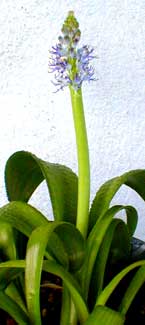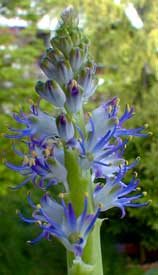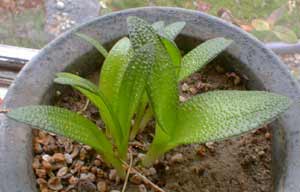
Sweet Violet Lachenalia
In 2000 Granny Artemis brought home a little plant from the Indoor Sunshop that consisted of two fat bumply succulent leaves. For all we knew at the time, a couple bumply leaves was all there would ever be of Lachenalia purpureo-caerulea, for it was obtained strictly on the oddness of the warty leaves.
 It was sold as a one-off offering on a table full of mixed small succulents, so we did not not at first realize it was not a succulent, but a bulb. For the next three years it never bloomed, & it had leaves only in winter & spring. The rest of the year it is just a pot of soil with the tip of a bulb slightly showing at the surface. In April 2004 it flowered for the first time.
It was sold as a one-off offering on a table full of mixed small succulents, so we did not not at first realize it was not a succulent, but a bulb. For the next three years it never bloomed, & it had leaves only in winter & spring. The rest of the year it is just a pot of soil with the tip of a bulb slightly showing at the surface. In April 2004 it flowered for the first time.We found instructions for the care of our Violet Lachenalia. Such bulbs need to be watered well in winter, little in summer, as lachenalias from the Cape of Good Hope are most active in the winter rainfall season & early spring, & go dormant in the overly hot & dry summers.
The foliage is deciduous. The sword-shaped leaves coil back on themselves, & are usually limited to only two leaves a year. After several years there may finally be more than one pairs of leaves. Ours at age four finally began producing a half-dozen leaf-pairs, so that it has begun to look quite leafy, as can be seen in the first photo. The third photo shows just some of the leaves in January; this shot also captures the bumpiness of the leaves.
 For us it is a house plant, but further south it can be grown in the outdoor gardens on rockery ledges. The bulbs are planted in autumn in a sunny position. Soil should be on the light side & contain much sand. It can also be multiplied from leaf-cuttings.
For us it is a house plant, but further south it can be grown in the outdoor gardens on rockery ledges. The bulbs are planted in autumn in a sunny position. Soil should be on the light side & contain much sand. It can also be multiplied from leaf-cuttings.Lachenaleas are of the hyacinth family. This ones blossom consists of numerous tiny bell-shaped purple flowers on a stock, forming a pyramid-shaped bloom that becomes more rounded & elongated as it ages. Also as it ages, the yellow-tipped purple stamins become longer & showier poking out of the tiny bells. This rather extravagant & sweet-smelling late winter or spring.
Many species of lachenaleas exist in the winter-rain belt of South Africa. When they were first discovered by Europeans, they were instantly popular. The East India Company began distributing lachenalia bulbs to flower lovers world-wide as early as the mid-1600s. They were originally categorized as Hyachinthus, but re-categorized in 1784 as Lachenalia, named after Swiss botanist Werner de la Chenal.